In recent years, strategy-execution frameworks have become more important in businesses. Especially in the past year, as teams across the globe moved to fully remote work or hybrid-model work, it has become vital for companies to have a framework to organize their strategy into actionable steps. OKRs are one such framework that has been gaining attention and credibility in mainstream business. Industry-leaders such as Google, Netflix, Spotify, and Amazon use OKRs to accomplish more with precision and purpose.
You can’t manage what you can’t measure
What are OKRs? As you probably already know, the structure of OKRs is as follows: a qualitative and aspirational objective statement, followed by three to five quantitative outcomes that help determine the success of the objective statement.
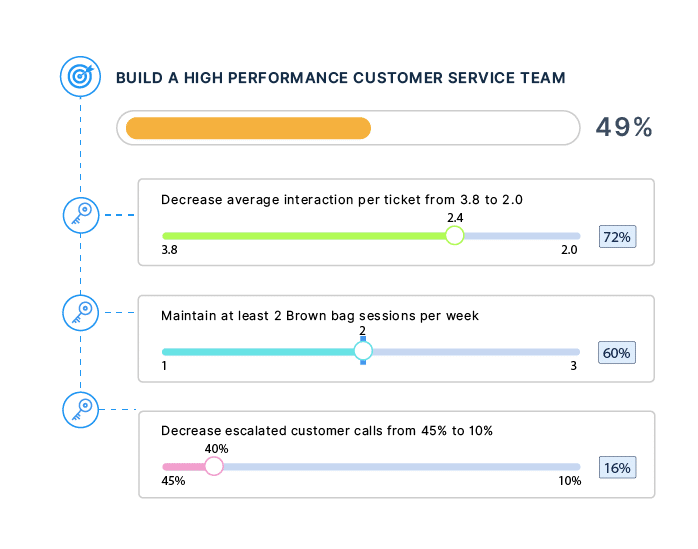
The OKR structure is an easy thing for everyone to understand, but the forethought and planning that must go into the process of writing a great OKR isn’t always as straightforward as we would like it to be. In this article, we’ll break down the process for writing a strong OKR.
Objectives
The first part of a strong OKR is the objective.
An objective, in theory, is very straightforward. This is a statement that must articulate what you want to accomplish. Ideally, this statement is ambitious, brief, and memorable. The set objective statements should make it clear what the top priority of the company, department, team, or individual is for a given quarter. Team members should ideally be able to read this at the beginning of the quarter and remember it without referring back to their OKR software or manager.
In order to write a quality objective, ask yourself the following questions:
- Is the objective inspiring?
- Is the objective simple and specific?
- Is there alignment with other objectives?
- Is the objective time-bound?
- Does the objective push the team?
Ensure that you can answer all of these questions “yes” before finalizing your objective. It’s important that your objectives meet these criteria in order to get the most out of the OKR framework.
Remember that objectives should not be measurable in and of themselves. Objectives are meant to speak towards your strategy, and break down a company’s top priorities into goals that can be focused on within a quarter. Key results will help you measure the success of this objective, so there is no need to add KPIs in the Objective itself. Instead, ensure that your objective addresses the most important thing you have to focus on in the quarter.
A poorly-written objective will be vague and uninspired. For example, “Refresh our onboarding process.” This is technically a goal, but it’s unambitious. You can rewrite this goal with the proper energy and inspiration behind it, changing it to: “Deliver a world-class onboarding experience for new hires.”
Key Results
While objectives are relatively straightforward, many teams struggle with the art of creating a good key result. There is some confusion surrounding what separates a good quality key result from a bad key result.
To help demystify the process of writing a great key result, consider these four classes of key results:
- Lagging indicator key results
- Leading indicator key results
- Activity-based key results
- Paired/Balancing key results
For each OKR, not all of these classes need to be used, but generally speaking, your key results will be a combination of these four classes.
You can try Profit.co’s OKR management software free today and use our guided OKR creation wizard so you can write great OKRs with ease and improve on your OKR writing skills!
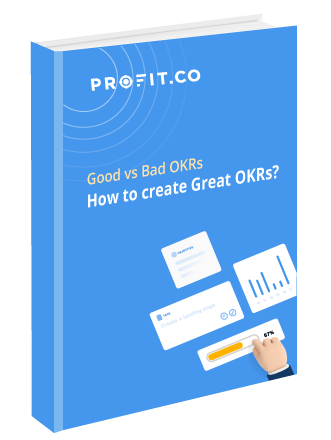
How to Create Great OKRs?
- Want to learn to write and roll out impactful OKRs?
- Are you interested to know the best OKR techniques and tips?
- Wish to hear about the common mistake while creating OKRs?
Lagging indicator KRs
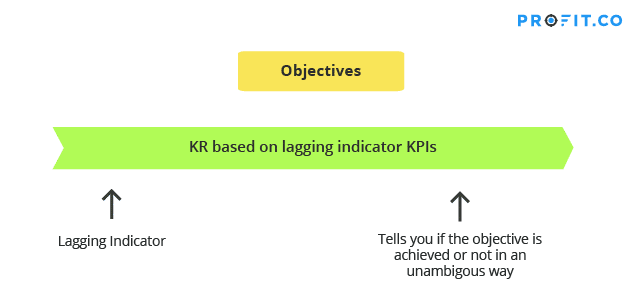
The best way to measure objective progress is to have KPI-based key results. KPIs, or key performance indicators, give concrete measurements of key outcomes in your business. If business execution is a road trip, OKRs are the destination you’re driving to, and KPIs are the information on your car’s dashboard– your speed, fuel level, engine temperature– all of the indicators of how your car is doing along the way.
KPIs, when measured, set as a target, and given a deadline, become key results.
Your key results for an objective must be mutually exclusive and collectively exhaustive. So, if your key results are all 100% complete, your objective must necessarily be complete.
Usually, you will have some KPIs already identified at the company level. As you go down through the organization from company OKRs to a more operational level, it may be more difficult to find the right KPIs. In most cases, though, you will be able to find a KPI that will help indicate if you have achieved your objective or not.
In other strategy-execution methodologies, such as Wildly Important Goals (The WIG Methodology) there is the concept of a lagging indicator. Lagging indicators are the metrics that measure the success of the objective directly. These can be difficult to measure, and are usually only measured towards the top layer of an organization.
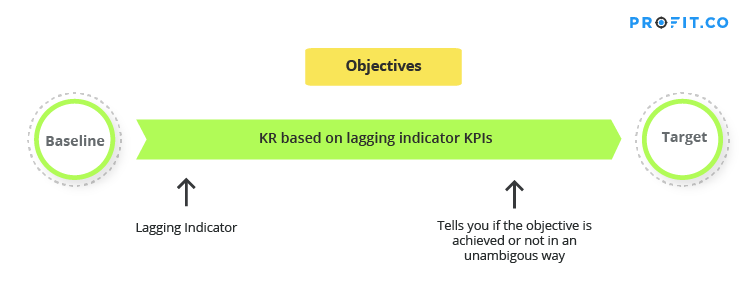
Topical key results are highly effective at helping you determine if you have achieved your objective. With lagging indicators, you usually have a baseline KPI available that you have recorded for multiple quarters.
Lagging indicators help measure production and performance accurately. These KPIs indicate if you have achieved your objective in clear, unambiguous terms. While these are the KPIs that provide the most clarity, they can be difficult to monitor directly, and there may be a limited number of these available to be tracked in a company.
An example of a lagging indicator is the number of sales closed within a week. This number is not something you can directly affect in your organization– instead, you need to do other activities or tasks that will impact this number. However, the number of sales closed is a great indicator of your revenue and the effectiveness of your marketing and sales teams, and an invaluable indicator to have available.
Creating key results from these indicators should be your first step when writing a new OKR.
Leading Indicator KRs
Meanwhile, leading indicators help show leaders how to produce desired results
For example, in Sales, you might want to hit a certain amount of revenue. In order to achieve that amount, you calculate that you will need to get 5,000 leads per week.
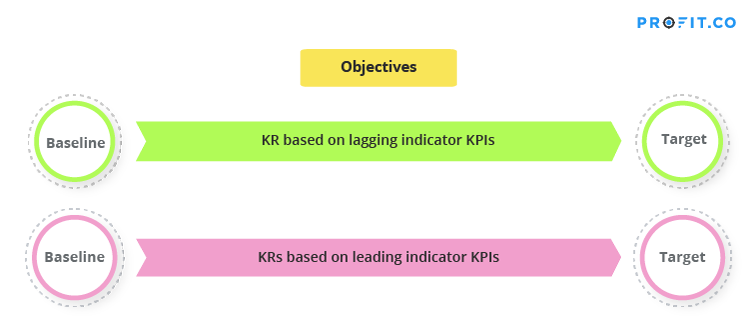
The amount of revenue is a lagging indicator. This is the outcome you want to produce. The number of leads is the leading indicator– or how you go about reaching the outcome you want.
The sales process from “number of leads” to “revenue” has many steps in between. A salesperson needs to complete demos with clients, write a proposal, and negotiate a deal in order to reach the closed sale and revenue. So, the number of leads is a leading indicator, as it comes before the closed sale/revenue marker in the sales process. If you measure leading indicators closer to this end point, such as the number of proposals written, or number of deals negotiated, you will have a stronger KPI that has a more direct impact on the lagging indicator you’re trying to measure.
At lower levels of the company, you might not have as many lagging indicators to track for department- or team-level OKRs. However, you will probably be able to define leading indicators.
So, if the Sales department has an assigned objective to Substantially Grow Revenue, they will not use “Revenue” as a KPI. Instead, they will use leading indicators that will necessarily affect revenue– such as the customer renewal rate, lead to sales conversions, and customer churn.
Key results based on leading indicators should be used when lagging indicators do not make sense for the given objective, or if OKRs are set at lower, more operational levels of the company.
Activity-Based KRs
And then, you have Activity-Based Key Results. Activities, or outputs, is the tangible tasks and targets employees produce with their day-to-day work. Companies should avoid using activities as their first means of tracking key results. However, at team and individual levels, it makes more sense to set key results using activity-based KRs.
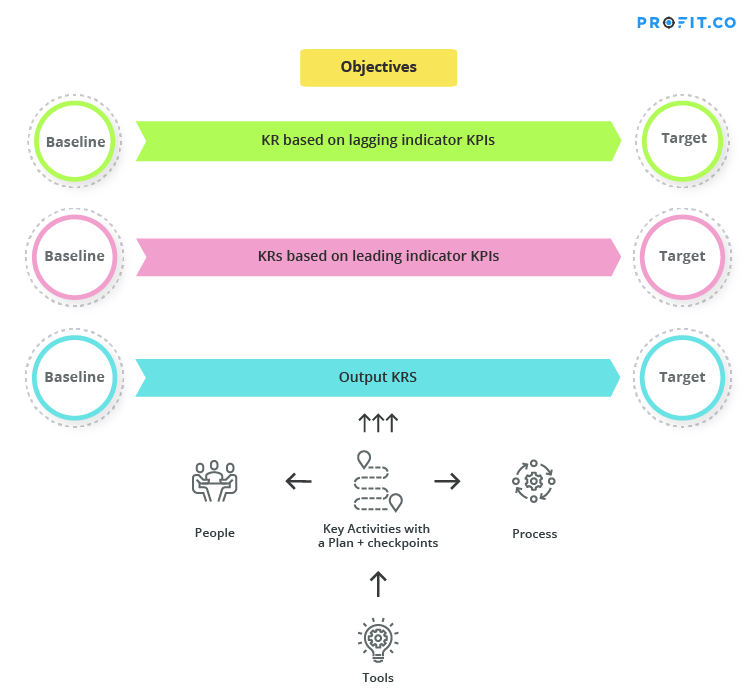
The more granular OKRs become, the more likely you will see activity-based key results. When you delegate key results to a department, team, or individual, key results like these are ultimately necessary to help achieve the overall objective.
These key results might not necessarily be attached to a KPI. It is not uncommon to have milestone-tracked output-based key results. In general, this class of key results will be handled and achieved using people, processes, and tools.
Balancing Key Results or Paired Key Results
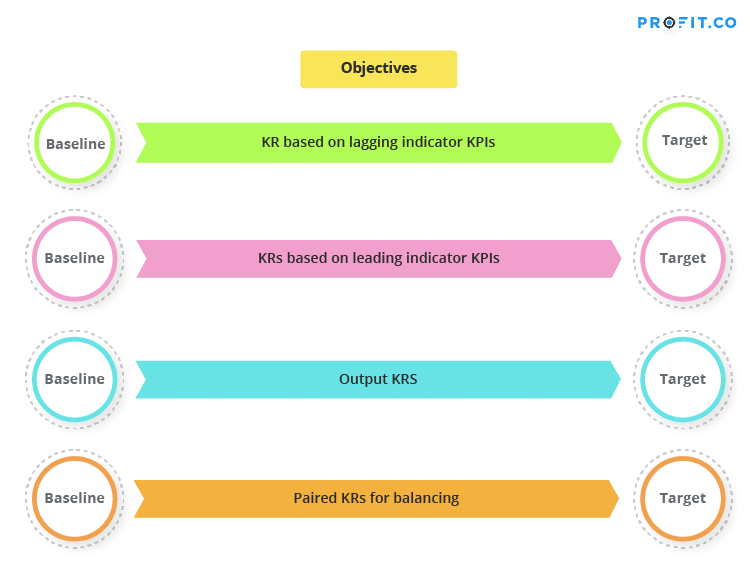
Once you have completed creating key results using lagging indicators, leading indicators, as well as activity-based KRs, you can use the final key result type, which we’ll call the balancing or paired key result.
When companies do use this class of key result, it’s usually in regard to efficiency. All teams need to strike a careful balance between speed and quality, producing as fast as possible without sacrificing the quality of what they are producing.
These key results are used to ensure that people don’t lose sight of the importance of quality, which is entirely possible when team members are focusing on KPIs and tangible outcomes.
Do all OKRs have to have this kind of a structure?
No, not all OKRs follow this structure we’ve laid out above. Different levels of the company require different classes of key results in order to measure progress and fulfill objectives. In our experience, the distribution of these key result classes varies as shown in this diagram:
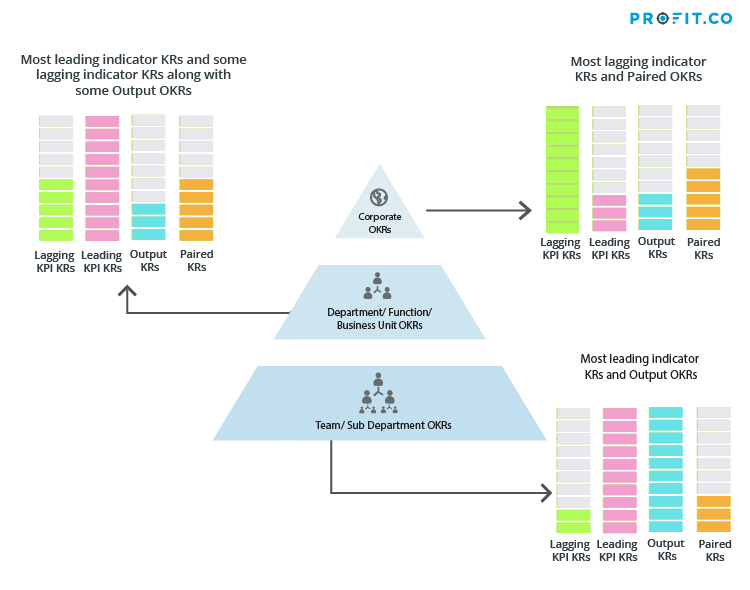
The distribution of these four classes of key results will necessarily vary across the three most common layers of OKRs: the corporate, department, and team levels.
At the corporate OKR level, you will see mostly lagging indicators. Additionally, there are sometimes a few paired OKRs to help break up any KPI-exclusive tunnel vision your team might have. This isn’t to say that a corporate level never uses leading indicators to create key results, however this class of key results should be used sparingly at this level of an organization.
For example, take a look at this OKR to Grow Revenue.
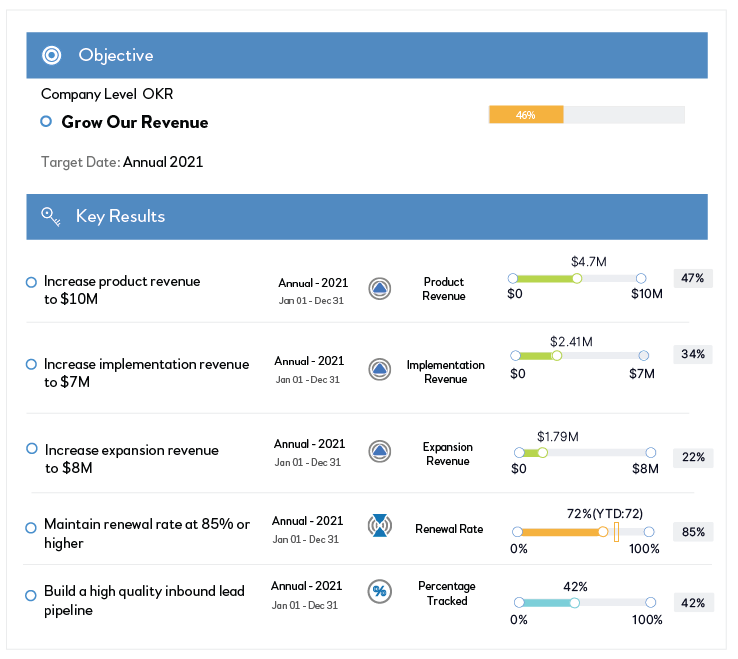
- KR 1: Increase product revenue to $10M
- KR 2: Increase implementation revenue to $7M
- KR 3: Increase expansion revenue to $8M
Key results one, two, and three are all lagging indicators. These targets directly measure the success of the objective because they are tracking revenue.
- KR 4: Maintain renewal rate at 80% or higher
Meanwhile, the fourth key result to maintain the renewal rate at 97% or higher is a balanced key result that will help the business maintain the quality of their service.
- KR 5: Build a high quality inbound lead pipeline
The fifth key result can be considered an activity-based key result– and in the next example, we’ll see this was cascaded down as an objective for the marketing department.
At the middle level of an organization, the department or business unit level, you will start to see more leading indicators. Lagging indicators, and perhaps a few activity-based key results will be mixed in with these leading indicators, but the majority will always be leading indicator-based key results. This is because department OKRs are commonly aligned with the company level OKRs, and they will use KPIs that help the corporate level see the KPIs they want to see to achieve their goals.
Let’s take a look at an OKR for the marketing department:
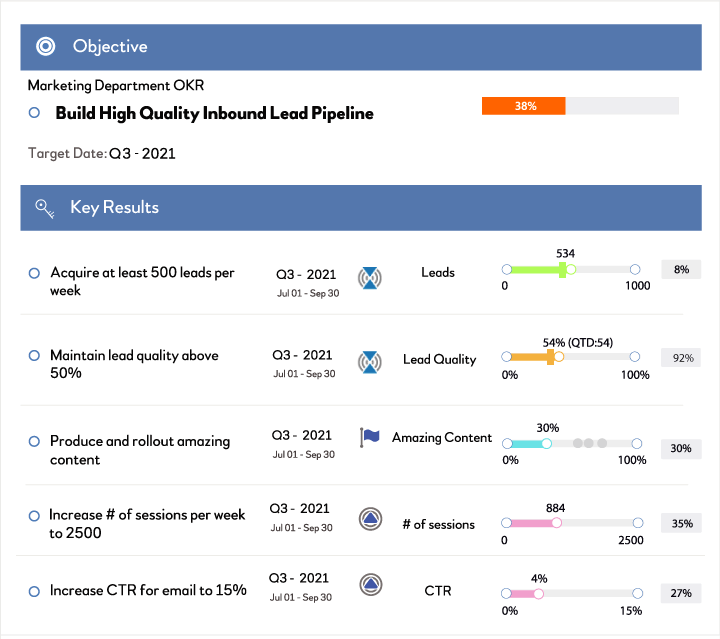
- KR 1: Acquire at least 500 leads per week
The first key result for this marketing department OKR is a lagging indicator. This is a lagging indicator because the success of this target informs us about the quality of the lead pipeline. Our target here is directly measuring the objective.
However, if this key result were to appear at the company level, for example, it would be a leading indicator. This is because leads directly affect the ability to generate revenue. If a business does not acquire 500 leads per week, it won’t be possible to reach its revenue goal. Yet, even if they do reach their lead target, it’s far from a sure thing– there are still more components in the sales process that come before revenue. Getting quality leads each week is just one ingredient to a successful target.
- KR 2: Maintain lead quality above 50%
The second key result to maintain lead quality above 50% is a balanced key result, which is important to have at this level, though not very common.
- KR 3: Produce and rollout amazing content
The third key result, to produce and roll out content is an activity-based key result, as content will help generate leads.
- KR 4: Increase # of sessions per week to 2500
- KR 5: Increase CTR for email to 15%
Lastly, key results four and five are both leading indicators, since these KPIs will impact the production of leads, but do not directly measure leads themselves.
Finally, at the operational level, you might have a few lagging indicator key results and some balanced key results, but mostly you will see leading indicator key results and activity-based key results.
Let’s take a look at the content team’s OKR at the functional level:
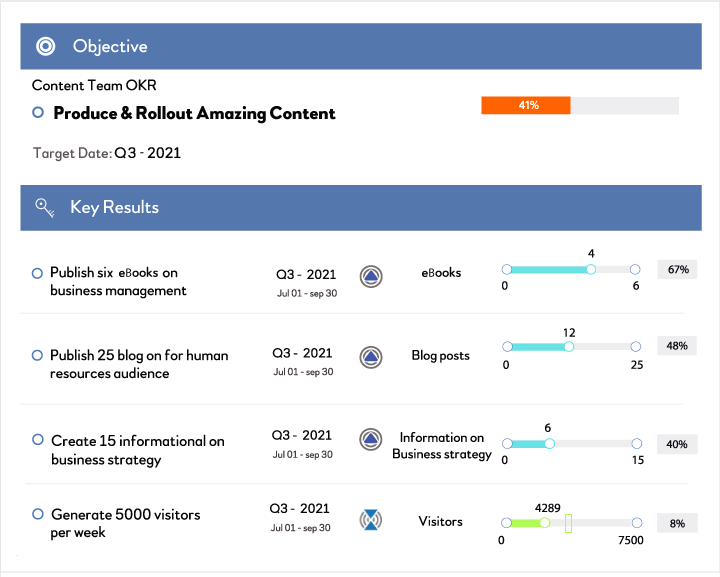
This OKR demonstrates the standard distribution of key results at the sub-department, team, or individual level of a company.
- KR 1: Publish six eBooks on business management
- KR 2: Publish 25 blog for human resources audience
- KR 3: Create 15 informational on business strategy
Key results one, two, and three are all activity-based key results. These key results are usually measured using tasks.
- KR 4: Generate 5000 visitors per week
Key result number four, to generate 5000 visitors per week, is a lagging indicator.
Final Thoughts
As you and your team write OKRs for your company, you’ll want to keep in mind the bigger picture of your organization and prioritize goals accordingly. KPIs used at the company level most likely won’t work for key results at the department or individual level. Keeping a close eye on what kind of key results your team is writing, and how each tier of the company feeds into one another, is all part of having a strong OKR program.
Like any skill, writing great key results will become easier with time. As a leader, you can make a point to maintain full transparency in your organization, as well as ensure your team has the required tools to write and execute their OKRs. Profit.co, the most intuitive OKR management software in the market, can help provide your team with the resources they need to successfully write and execute OKRs. You can book a demo with our OKR experts to learn how Profit.co can help you focus on your priorities, measure your progress, and achieve your goals.
Related Articles
-
Profit.co is FedRAMP Ready. Trusted Execution for Federal Agencies Just Got Simpler
In a world where data security, compliance, and mission success are non-negotiable, Profit.co stands out as a trusted partner for... Read more
-
Tim Newbold: Drive OKR Outcomes with Confidence Scoring
You're not alone if you're unsure how confident your team is about achieving its OKRs this quarter. Many teams operate... Read more
-
Tim Newbold on Leading Outcome-Obsessed Teams with OKRs
In many team meetings, a recurring pattern emerges Team members provide updates such as, “I completed tickets 247 and 248,”... Read more
-
How Top Teams Win with Weekly OKR Check-Ins – Insights from Tim Newbold
Set a goal. Cross your fingers. Hope for the best.Sounds familiar?That’s how too many teams treat OKRs. They set goals,... Read more

